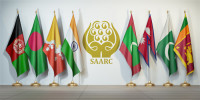Opinion
Politico-diplomatic quandary
Nepal, sandwiched between the two populous and fast rising economic and military powers, China and India, has a difficult task of managing its vital neighbourhood diplomacy, economy and political stability and is currently in the midst of a serious politico-diplomatic quandary.
Som P. Pudasaini
Nepal, sandwiched between the two populous and fast rising economic and military powers, China and India, has a difficult task of managing its vital neighbourhood diplomacy, economy and political stability and is currently in the midst of a serious politico-diplomatic quandary.
Current landscape
While Indo-Nepal relations go a long way, the modern chapter follows Indian independence in 1947 and the 1950 treaty between the two countries. An Expert Group of Eminent Persons from India and Nepal is currently drawing up suggestions pertaining to Indo-Nepal relations that will be submitted to both governments by July 2018. These suggestions will touch on ways in which past agreements such as the 1950 treaty can be changed in a manner that suits the context of the 21st century and is satisfactory to both countries. India’s security concerns and its perception that the Himalayas are under its sphere of influence affects Nepal’s sense of sovereignty. India’s interference—either real or perceived—in Nepal’s politics is widely held to be a key source of political instability and India’s periodic economic blockades impinge on the sentiments of the Nepalis, on Nepali politics and on the economy.
The modern history of Nepal-China relations started in 1955, when Nepal established diplomatic relations with the People’s Republic of China. The placement of resident ambassadors, a boundary settlement agreement and the signing of the peace and friendship treaty in 1960 cemented China-Nepal dealings further. While China largely pursued a hands-off policy in Nepal’s internal affairs in the past, since 2015, it has started to play a more active role in Nepal’s political affairs.
Nepal adopted a new constitution in 2015 with an aim to conclude the political transition and expedite economic growth through the establishment of a Federal Democratic Republic. And in the recent elections, the leftist alliance gained an absolute majority. It has been alleged that China supported the formation of the left alliance and its election initiatives. There is also speculation that India did the same in favour of the democratic alliance. Nepal’s political stability, trade, security and development hinges on its ability to delicately and pragmatically balance its relations with the two Asian giants, so our politicians must manage Nepal’s multifaceted relations with them prudently.
Four important factors shaped the core of the politico-diplomatic quandary. The first was the 2015 Indian economic blockade that pushed Nepal to seek an alternative supply source and transit point from China, particularly for petroleum products and essential supplies. The second is the Belt and Road Initiative (BRI) undertaken by China. Nepal agreed to be a part of the BRI in order to draw increased investment from China, particularly for infrastructure development. The third factor has to do with China’s rise as the second most important global economic, military and political power, and its aim to expand its influence in South Asia. India and its allies have protested against China’s effort to expand its influence in the region. The fourth factor concerns the adoption of a new constitution and effective institutionalisation of a federal democratic republic with necessary adjustments.
Neighbourhood diplomacy
Nepali leadership, whether left or democratic, must be prepared to tackle the politico-diplomatic quandary with sincerity and commitment. They may have to be realistic that given cultural as well as geographic proximity and better topographic accessibility, India is likely to be a more feasible and cost effective source of supplies. However, China-Nepal relations are changing and must be developed as a reliable alternative for investment and essential supplies. Faster development of the northern areas of Nepal, hydro-power and infrastructure depend on our relations with China to a great extent. That being said, we must not completely disregard Indian and western scepticism in regards to the BRI.
The BRI offers Nepal numerous opportunities to attract investment in infrastructure. However, the benefits arising from it may not be as great as they have been made out to be by our politicians who no doubt have vested interests. Nepal falls on the periphery of the BRI. Also, BRI projects will be funded by China under interest paying loans. Unless the infrastructure projects that are developed are Nepal’s priority and the loans used generate enough income through productive economic activities, they might turn out to be a liability as repayment with interest may unduly burden Nepal’s economy as evidenced by the Hambantota Port that Sri Lanka had to lease to China for 99 years.
Nepal’s protracted political transition is at a critical point, as the local, state and national level elections have now been completed. The left alliance won a majority in the National Assembly elections; it registered wins in six out of seven of the state assemblies and will form its government within a few months. With a new government that has an absolute majority in parliament, it is hoped that there will be political stability over the next five years, and that internal political horse-trading and undue external influences, particularly from big neighbours, will be minimised, thus leading to rapid economic growth. However, there is scepticism regarding the new left alliance government and whether it will rise above political factionalism, nepotism, massive corruption, and politico-business-criminal nexus and pragmatically deal with our powerful neighbours to deliver political stability and economic wellbeing.
Ishwor Pokhrel, UML General Secretary, on December 14, 2017 stressed in a newspaper interview that his party was neither “anti-India” nor “pro-China”. But it will implement the 15-point joint communiqué signed with China in March 2016 covering transportation, trade and financial cooperation. SD Muni, a retired Professor of Jawaharlal Nehru University says “it would be a mistake to read the emergence of the Left Alliance as Nepal’s preference for communism”. He added “Nepali voters have clearly expressed their new nationalism which has three key components—the search for political stability and peace, the demand for fast and comprehensive development and assertion against India”. He cautioned India that it must now cope with “the victory of the Left Alliance and the rise of new Nepali nationalism”. Indian columnist KC Singh argues “the victory of the left alliance is not good for India” and the Indian mandarins will face “competition with Beijing for the affection of the rulers of Kathmandu”.
The new left alliance government’s ability to stay in power for five years, honest implementation of promised development and its capacity to pragmatically work with the opposition, the Nepali Congress and the Madhesi parties, will determine the future politico-diplomatic course. Its ability to pursue realistically balanced relations with both India and China, including in matters related to trade, investment, geo-politics and the BRI, is crucial. Nepal must have a pragmatic and consensus-based national foreign policy that is agreed upon by major political parties and adopted by parliament. In the absence of consensus based foreign policy, political leaders, political parties and governments have either invited external interference to suit their personal or party interests, or meekly accepted undue interference instead of acting with the national interest in mind.
Pudasaini is former UNFPA Representative for Sri Lanka and Yemen and Country Director for the Maldives




 10.12°C Kathmandu
10.12°C Kathmandu










